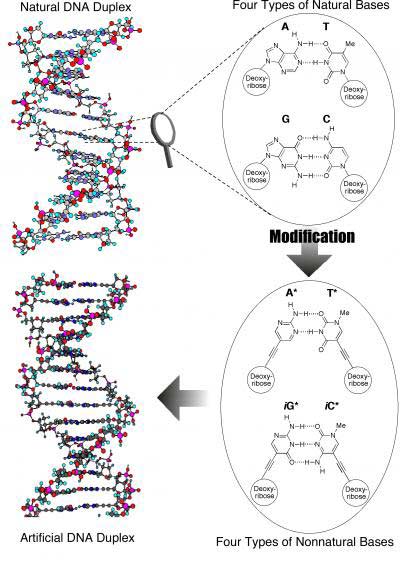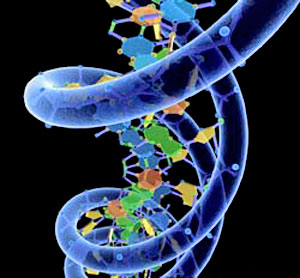|

by Robert Roy Britt
LiveScience Managing Editor
05 July 2008
from
LiveScience Website

Scientists are
reporting synthesis of the world's first DNA molecule
made almost of
entirely artificial parts.
The discovery could
be used in the fields of gene therapy
and other futuristic
high-tech advances, such as nano-sized computers.
Credit: Courtesy of
Masahiko Inouye
Chemists claim to have created the world's first DNA molecule made
almost entirely of artificial parts.
The finding could lead to improvements in gene therapy, futuristic
nano-sized computers, and other high-tech advances, the Japanese
researchers say. DNA, popularly illustrated as a double helix, holds
the blueprints of life (below insert) and controls what every living
organism becomes and how it functions.

Scientists have tried for years to
develop
artificial versions of DNA in order
to take advantage of its amazing information storage capabilities.
Already, DNA has been harnessed to
create simple electronic circuits.
DNA uses just four basic building blocks, known as bases, to
code proteins used in cell functioning and development. Other
researchers have crafted DNA molecules with a few artificial parts.
|
Genes - The Instruction Manuals
for Life
by Corey
Binns
29 May 2006
from
LiveScience Website
A gene is a 'how-to' book for making one product - a
protein.
Proteins perform most life functions, and make up almost
all cellular structures. Genes control everything from
hair color to blood sugar by telling cells which
proteins to make, how much, when, and where.
Genes exist in most cells. Inside a cell is a long
strand of the chemical DNA (deoxyribonucleic acid). A
DNA sequence is a specific lineup of chemical base pairs
along its strand. The part of DNA that determines what
protein to produce and when, is called a gene.
Inside genes
The term gene, first created by Danish botanist
Wilhelm Johannsen in 1909, comes from the Greek word for origin,
genos.
The number of genes in an organism's complete set of
DNA, called a genome, varies from species to species.
More complex organisms have more genes. A virus has a
few hundred genes. Honeybees have about 15,000 genes.
Scientists estimate that humans have around 25,000
genes.
Each gene has many parts. The protein-making
instructions come from short sections called exons.
Longer "nonsense" DNA, known as introns, flank the exons.
Genes also include regulatory sequences. Although
scientists don't fully understand their function,
regulatory sequences help turn genes on.
Each gene helps determine different characteristics of
an individual, such as nose shape. Full of information,
genes pass similar traits from one generation to the
next. That's how your cousin inherited grandpa's nose.
Peas in a pod
The "Father of Genetics,"
Gregor Mendel, was an
Austrian monk who experimented with plants growing in
his monastery. He studied inheritance in pea plants
during the 1860s.
Mendel observed that when he bred plants that had green
pea pods with plants that had yellow pea pods, all of
the offspring had green pods. When Mendel bred the
second generation with one another, some of the baby
pods had green pods and some had yellow pods.
He discovered that a trait, or phenotype, could
disappear in one generation and could reappear in a
future generation.
Individuals have two copies of each gene, one inherited
from each parent. Mendel explained how these copies
interact to determine which trait is expressed.
In all peas there is a gene for pod color. The pod color
gene has green and yellow versions, or alleles. Mendel's
green pod alleles are dominant, and the yellow pod
alleles are recessive. In order to express a recessive
form of the trait (yellow in above image), individuals must inherit
recessive alleles from both parents.
A plant that inherits one green allele and one yellow
allele will be green. But it can still pass the
recessive yellow allele onto its offspring. That's how
some of Mendel's pea pods came out yellow.
More to it
Human diseases such as sickle cell anemia are passed
down in a similar way.
However, genetics don't always work so simply. Most
genetics and instances of heredity are more complex than
what Mendel saw in his garden.
It often takes more than a single gene to dictate a
trait; and one gene can make instructions for more than
trait. The environment, from the weather outside to an
organism's body chemistry, plays a large role in
dictating traits too. |
But
Masahiko
Inouye and colleagues at the University
of Toyama used stitched together four entirely new, artificial bases
inside the sugar-based framework of a DNA molecule, creating
unusually stable, double-stranded structures resembling natural DNA,
they say.
Like natural DNA, the new rip-offs were right-handed and some easily
formed triple-stranded structures.
"The unique chemistry of these
structures and their high stability offer unprecedented
possibilities for developing new biotech materials and
applications," the researchers said in a statement.
The breakthrough will be detailed in the
July 23 issue of the Journal of the American Chemical Society.
"The artificial DNA might be applied
to a future extracellular genetic system with information
storage and amplifiable abilities," the researchers write.
|


